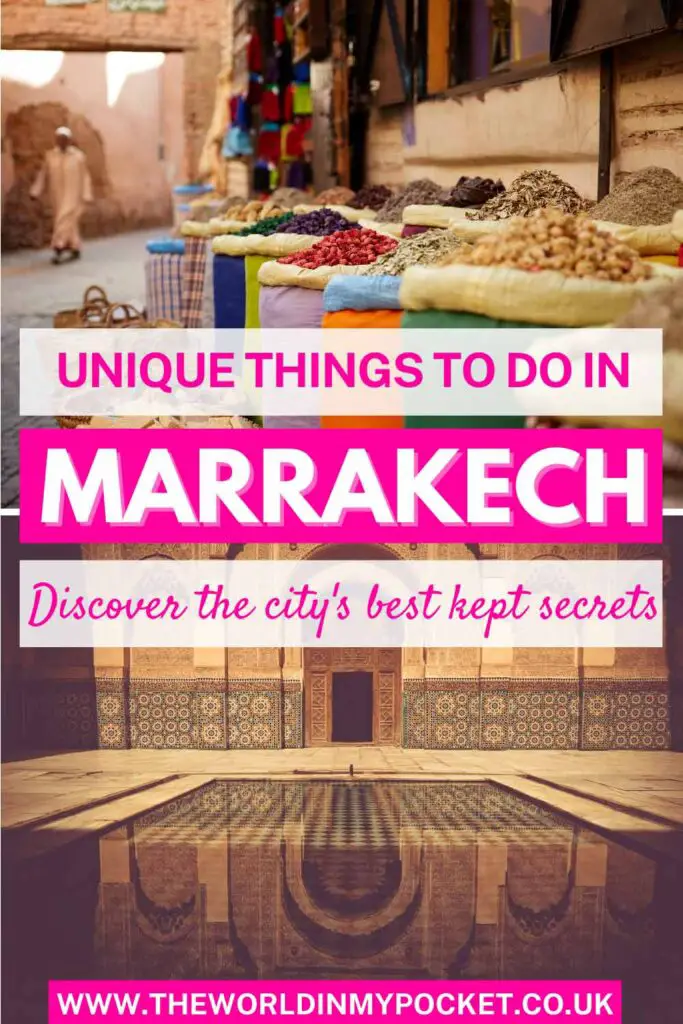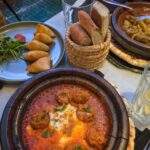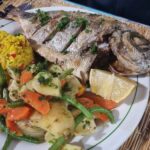What an incredible place Marrakech is! There are so many wonderful unique things to do in Marrakech, as well as visiting the tourist attractions. From learning more about Moroccan culture to indulging in a traditional roast lamb lunch on the Mechoui Alley, there are plenty of intriguing experiences that will make you fall in love with this vibrant city. I was surprised how just walking a few steps away from the hustle and bustle of the medina, I found myself surrounded by a small oasis of peace. I thought Marrakech was a city of contrasts, vibrating in every corner, but with plenty of more peaceful places with quietness dotted around the major tourist attractions.
And this is what we are going to cover today, these incredible places and experiences that will elevate your trip to Marrakech to help you understand the city, its history and its customs better.
Unique Things to Do in Marrakech

I wasn’t expecting to do so many unique things in Marrakech. I spent quite a bit of time in this fantastic city, which can both enchant but also mentally drain you as there is so much to take in. So here are my suggestions on the things you have to do when you visit the most famous city in Morocco, to learn about the local history, traditions, as well as immerse yourself in its culture. I have recently visited and experienced all these places, to curate this list of unique things in Marrakech for you. I hope you enjoy reading about Marrakech’s best kept secrets.
Attend a Moroccan Storytelling Evening

I can’t remember when I first heard about the Moroccan storytelling evenings at Café Clock, which happen every Thursday, but I knew I wanted to attend.
The storytelling evenings are a great way to learn more about the culture of Morocco, whilst enjoying a traditional local dinner. They are free to attend, and I recommend getting there half an hour earlier, so that you can get a table with a good view.
The performance is in both English and Arabic, and they are not just entertaining, but there are also both lessons and morals to be learned from each story. Moroccan storytelling is an old art, dating back thousands of years. This is when the city’s popular Jamaa-el-Fna square was the meeting point of caravans travelling north or south. The caravans coming from the south knew that this was the point where the scenery would change, with plenty of water and greenery. The caravans heading to the south however, knew that this was the last point before the harsh conditions of the arid desert. At this meeting point, people would meet and entertain each other with dances, music, and storytelling.
Even today, Jamaa-el-Fna square is popular with storytellers, who you will recognise by the crowds that are gathered around them. But their stories are in Arabic, and visitors won’t understand them. This is why Café Clock is a great place to visit if you want to take part in this unique experience in Marrakech.
Learn How to Cook a Tagine

Even though couscous is the national dish of Morocco, it is the tagine that is the most popular. Whilst couscous is a celebratory dish eaten usually on a Friday, tagine is omnipresent at the restaurants around the country. And what better way to learn more about the origins of this traditional Moroccan dish than learning how to cook it during a cooking class?
I didn’t want to miss the opportunity of going on a unique culinary adventure in Marrakesh so I booked a tagine making class, which included a visit to the market as well. In total, we cooked seven different dishes: four appetisers, one vegan and one chicken tagine, as well as an apple dessert. The class started in front of the Bab Doukkala Mosque, in a local, less touristy area of Marrakech, where we met one of our chefs, Kawtar. There were 8 people who booked this class, and each of us was put in charge of picking some of the ingredients we needed from the market. I picked the aubergines, which we used for the zaalouk, a typical Moroccan salad made from aubergines and tomatoes.
The class was very hands-on, with each of us getting involved in preparing every single dish. Whilst chopping the vegetables and mixing the seasoning with herbs, I learned about the traditional Moroccan spices, as well as how to make a tagine without the typical pot is usually cooked in, in Morocco. It was a fantastic interactive experience, from which I’ve learned a lot.
You can book the same cooking class I did by clicking here – the price is £35.
Visit the Jewish Cemetery

The Jewish Cemetery is not a well known touristic attraction in the popular guides of Marrakech, but it is a very interesting place to visit if you are looking for something unique to do in the city. The Juif de Miarra cemetery is the largest of its kind in Morocco and it’s extremely well preserved.
Morocco used to have a very large Jewish population, but these days there are only around 200 people still living inside the walls of the Mellah – the Jewish neighbourhood of Marrakech. The cemetery is believed to have existed since the 12th century and has over 20,000 graves. As you walk through it you can see the different gravestones, some looking extremely old, as well as mausoleums dedicated to the most important rabbis.
Visiting the cemetery costs 10 dirhams. Click here for directions.
Explore the Mellah of Marrakech

The Mellah of Marrakech is a very interesting place to visit. Now a small area, home to 200 people only, the Mellah was a very important commercial area between the 16-17th centuries. The Jewish community in Maroc started to grow after the Spanish Reconquista, when they were expelled from the Iberian Peninsula. The Mellahs in Morocco were created as communities where they could live as protected non-Muslims.
Walking along the streets of the Mellah you will get to observe the daily life of the people who still live here. The alleys are narrow, flanked by tall buildings in sandy colours. The busiest place within the walls of the Mellah is the local market, where you can find a large range of products, from fresh fish to mint and vegetables.
You shouldn’t miss the al-Azama Synagogue in Mellah, which is free to visit. You can easily pass by without noticing it, as from the outside it looks just like any other building in the area, distinguishable only by a small sign on the wall.
Check Out the Carpet Museum

Minutes away from the beautiful Bahia Palace you will find a small but intriguing museum, away from the busy alleyways of the Marrakech Medina. The Dar Si Said is a proper gem, a unique place to visit in Marrakech. It not only tells the story of the weaving in Morocco and the different patterns associated with each region of the country, but it is also housed in an incredible building, an old palace ornated with mosaics and carved wood doors and ceilings and an intimate courtyard with water features.

The carpet industry in Morocco has a deep history. The traditional Moroccan rugs are woven by hand, by artisans who have learned the technique and passed it from generation to generation. Each region in Morocco has their own typical rug style, with traditional motifs related to the area. For example, in the high Atlas mountains the rugs are thick, made from sheep’s wool and painted with vegetable dyes in bold patterns. This area is famous for the high quality Berbere rugs which are created by women who have the patterns in their minds, creating the beautiful rugs as they go.
At the Dar Si Said museum you can see the difference between the carpets made in the Atlas mountains and the rugs woven in the Sahara desert, and how different they are from each other. The palace itself is worth a visit, for its stunning architecture and décor.
The entry fee to the Dar Si Said Museum costs 30 dirhams. Click here for directions.
Buy Warm Bread From the Community Oven

The Medina of Marrakech has a very tight knit community. There are different areas, which you could call small neighbourhoods, and each of them is served by a mosque, a school, a fountain, a hammam, as well as a communal oven. The medina itself is like a working city, with houses where people live, functional working structures, crafts and markets. Life in the medina goes on among the crowds of tourists which are in awe of the buzz of the souks or the beauty of the Riads.
Each community in the Medina of Marrakech is served by a community oven, where locals who don’t own modern kitchen appliances still bring their dough in the morning, to be baked. In the afternoon, the people working at the community ovens are making the dough and bake their own bread, which you can buy as it comes out of the flames.
Find Out How Tanjia is Cooked

One of the most interesting and unique things to do in Marrakech is finding out how tanjia is cooked. This typical Moroccan dish to Marrakech is a delight for the taste buds. The tender lamb meat slowly cooked in its own fat alongside preserved lemons not only melts in your mouth but will also make you crave more and more.
Tanjia is a meat dish that is cooked in an amphora-like ceramic jar that bears the same name. It is a celebratory meal made to be shared with friends or family. Locals usually go to their local butcher, who will fill the tanjia with the desired type of meat, as well as spices such as cumin, saffron and turmeric. Then, they would take it to the hammam, to be slow cooked in the ashes of the giant oven that heats up the water. The bathhouse worker is informed what type of meat is inside the jar, so that he knows for how long he should leave the tanjia inside the oven, buried in ashes.

This is a unique way to cook meat, typical to Marrakech. The meat is taken out of the dish and shared in the middle of the table, enjoyed with bread, and dipped in salt and ground cumin.
Even as a tourist you can borrow the tanjia from a butcher, have him fill it with meat for you, and then take it yourself to the hammam. For a small fee, you will get it cooked the traditional way. Just collect your tanjia later and enjoy it on the rooftop terrace of your Riad.
Explore Gueliz

If you want to see a different, modern part of Marrakech, you must take some time to explore Gueliz. Located just a few bus stops away from Koutoubia, Gueliz is worth exploring for its large boulevards, upscale restaurants, fancy coffee shops, shopping malls and supermarkets, Art Deco Architecture, as well as the popular Majorelle Gardens and the Yves Saint Laurent Museum.
Initially, Gueliz was built as a neighbourhood for foreign citizens living in Marrakech, but soon it became a popular place for locals.
Shop at the Mall
Whilst the souks of Marrakech are amazing places to buy spices, souvenirs and ceramics, if you want to catch up with the latest fashion in Morocco, you must head to the mall. You will find big brands here such as Zara, H&M, LC Waikiki and even Starbucks.
Have a Cheeky McDonalds

You may be asking, Joanna, why on earth are you telling us that going to McDonalds is a unique thing to do in Marrakech? Well, let me explain!
McDonalds has a slightly different menu, depending which country you are in. I make a habit of visiting the local McDonalds when I am in a different country, to see what those special items on the menu are. At home I would very rarely go to McDonalds, maybe just once a year. I do however find this a fun challenge, and that’s why I am recommending it as well.
I must say, I wasn’t disappointed with the special items on the McDonald’s Menu in Morocco. Firstly, I highly recommend ordering the McFlavour fries – loaded chips with either cheese and crispy onion, or Algerian sauce. I also tried the Chicken Big Mac, which was very good. Other products that I noticed were different from what we have here in the UK were the wraps with honey mustard sauce or with the Algerian sauce, the cheese croquettes with pepper, the McFizz Pina Colada and the McFizz Pomegranate Rose.
Stay in a Traditional Moroccan Riad

Staying in a riad is a unique experience that you must have when you visit Marrakech. Riads are beautiful traditional Moroccan houses with an interior courtyard and sometimes a water feature in there, like a fountain surrounded by palm trees and other vegetation. The balconies are all facing the interior courtyards, and there are very few windows towards the street.
Some of the Riads in the Medina have been transformed into guest accommodation, so that tourists can experience the old traditional way of life in Marrakech. There are plenty of Riads to choose from, some more luxurious than others. Most of the Riads also have a rooftop terrace where, sometimes, you will find a dipping pool.

The more luxurious Riads also have their own hammams, where you can enjoy a relaxing scrubbing before bed. The beauty of a Riad is that it is not just accommodation, but a place to escape the noises of the city. As soon as you step into the courtyard, the sounds suddenly stop, as if the rectangular shaped building is a barrier for the tumult happening outside its walls.
The Riad I stayed in Marrakech was mid-range, priced at £50 a night. The room was beautifully decorated in a traditional style, with colourful fabrics and typical mosaic lamps. I was warmly welcomed when I arrived, at midnight, the owner coming to pick me up from the gate to the Medina and offering me mint tea and cookies. Most of the Riads are in alleyways, some easier to find than others. The Riad also had a plunge pool on the rooftop terrace and a pretty relaxation area. If you want to book the same Riad, you can check their reviews on TripAdvisor, or the latest prices on Booking.com by clicking here.
Dive Into the Street Food

I love that you can find so much delicious street food in Marrakech. In this buzzing city you will never go hungry! In fact, at night, Jemaa el-Fnaa transforms into a massive street food market with sellers preparing the most delicious harira soup, lamb stews, grilled meats, tangia, fried fish as well as different sandwiches.
It is not just Jemma el-Fnaa where you will find street food in Marrakech. Just behind the market, close to the olive sellers, you will find the Mechoui Alley, famous for roast lamb. Come here for lunch and try the most tender roast lamb meat, served alongside bread, salt, cumin, and mint tea. You can buy any part of the lamb, by weight. Make sure to arrive before 2PM, when the lamb usually finishes for the day.
For a quick lunch, don’t miss the sandwich stalls dotted around the narrow alleys of the souks. The most popular sandwiches are filled with chicken or liver, which is cooked with vegetables and eggs in front of you, on a hot griddle.

Another great street food you can try in Marrakech is the snail soup. Look for the mobile carts with snails on them, usually surrounded by a crowd of locals. The soup is made with over 15 different spices which make it a fantastic winter warmer. You first scoop the snails out of their shells with a toothpick, and when you finish all of them, you drink the soup. I tried it and liked it.
When it comes to desserts, Marrakech delivers. There are plenty of street stalls selling all sorts of homemade cakes and desserts, from colourful nut cakes to doughnuts glazed with a crunchy sugar syrup.
Fruit juices are another staple of street food in Marrakech. Don’t miss the freshly squeezed pomegranate juice during its season, from August to December.
The best way to explore the flavours of Marrakech is through a food tour – which is what I did. You can click here to book a similar food tour that includes stops in several places and plenty of traditional dishes and drinks to try out.
Check Out a Natural Medicine Shop

I think that visiting one of the natural medicine shops in Medina is one of the most unique things to do in Marrakech. I’ve learned quite a lot about the use of spices and herbs, as well as how natural oils are made. When I visited Marrakech I had a nasty cough that wouldn’t go away. Whilst walking down the street, in the souk, one of the people running such a medicine shop stopped me and gave me a little pouch. He said to cover one nostril and take a deep breath – which instantly opened up my sinuses. He said that inside the pouch there was a mixture of nigella seeds and crystalised peppermint. He didn’t want to take any money, and wished me to get well soon.
I returned to his shop at a later date and had a chat about the different oils and creams they are making from natural ingredients. Each oil has a different purpose and can help the body in different ways. There are oils that relieve headaches, as well as oils that soothe the dry skin. I ended up buying a bottle of jasmine oil, which I use as perfume because it smells incredible.
Go to the Hammam

I personally love going to the hammam. But I understand that many travellers to Morocco don’t know what this involves. This is why I am including a visit to the hammam on my list of unique things to do in Marrakech.
Going to the hammam is a centuries old Moroccan ritual. It is a relaxing cleansing experience taking place inside a steam room. The local hammams in Morocco are public baths, separated by gender. As a tourist though, you won’t be able to go to a public hammam unless you buy all the utensils needed for this wellbeing experience: black soap, bucket, towels. Most tourists will go to private hammams which cost more, but where they will get a private session and an English speaking therapist.
Most people don’t know what to expect from a hammam when they go for the first time. Because you will be given paper underwear, it is better to bring your own bathing suit. As for what happens in the hammam, you will first be covered with black soap and then scrubbed on every inch of your body, vigorously, to remove all the dead skin. After, you will relax in the steam room for a half an hour or so. After the treatment, the skin feels as soft as a baby’s.
I was told at my Riad that the best time to go to the hammam is in the evening. The experience is so relaxing that you will want to go to bed straight away.
You can book a relaxing session at a trusted hammam by clicking here.
Fore more articles about Morocco, check out the ones below:
- The best things to do in Chefchaouen
- What to drink in Morocco
- Where to eat in Essaouira
- A 10 days in Morocco itinerary
Like it? Pin it!

Disclaimer: Some of the links on this website are “affiliate links.” This means that if you click on the link and do a purchase, I will receive an affiliate commission at no extra cost for you. This helps me keep my website running and continue to share my travelling knowledge with you. I thank you for booking your flights or hotels using the links on my website. Regardless, I only recommend products or services I use personally and believe will add value to my readers.





I haven’t read of the community ovens anywhere else. So interesting! Are they easy to find? Do you have a fav one?
I took a food tour and I discovered the community ovens through them. Usually, when you are near one, you will feel the smell of fresh bread. They are kind of hidden between the alleyways.
Whoa! This is indeed quite unusual list of things – attending a traditional Moroccan storytelling session sounds awesome. Bread in community oven? Wow! Sounds awesome. I really wouldn’t miss carpet museum. Visiting a natural medicine shop is something very intriguing. I’d like to do that. Wrapping up a day in relaxing hammam sounds great.